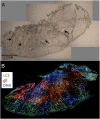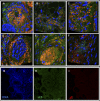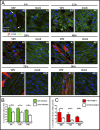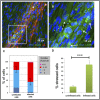Autophagic flux without a block differentiates varicella-zoster virus infection from herpes simplex virus infection
- PMID: 25535384
- PMCID: PMC4291665
- DOI: 10.1073/pnas.1417878112
Autophagic flux without a block differentiates varicella-zoster virus infection from herpes simplex virus infection
Abstract
Autophagy is a process by which misfolded and damaged proteins are sequestered into autophagosomes, before degradation in and recycling from lysosomes. We have extensively studied the role of autophagy in varicella-zoster virus (VZV) infection, and have observed that vesicular cells are filled with >100 autophagosomes that are easily detectable after immunolabeling for the LC3 protein. To confirm our hypothesis that increased autophagosome formation was not secondary to a block, we examined all conditions of VZV infection as well as carrying out two assessments of autophagic flux. We first investigated autophagy in human skin xenografts in the severe combined immunodeficiency (SCID) mouse model of VZV pathogenesis, and observed that autophagosomes were abundant in infected human skin tissues. We next investigated autophagy following infection with sonically prepared cell-free virus in cultured cells. Under these conditions, autophagy was detected in a majority of infected cells, but was much less than that seen after an infected-cell inoculum. In other words, inoculation with lower-titered cell-free virus did not reflect the level of stress to the VZV-infected cell that was seen after inoculation of human skin in the SCID mouse model or monolayers with higher-titered infected cells. Finally, we investigated VZV-induced autophagic flux by two different methods (radiolabeling proteins and a dual-colored LC3 plasmid); both showed no evidence of a block in autophagy. Overall, therefore, autophagy within a VZV-infected cell was remarkably different from autophagy within an HSV-infected cell, whose genome contains two modifiers of autophagy, ICP34.5 and US11, not present in VZV.
Keywords: Epstein–Barr virus; ICP34.5; SCID-mouse; autophagosome; autophagy.
Conflict of interest statement
The authors declare no conflict of interest.
Figures







Similar articles
-
A Novel Human Skin Tissue Model To Study Varicella-Zoster Virus and Human Cytomegalovirus.J Virol. 2020 Oct 27;94(22):e01082-20. doi: 10.1128/JVI.01082-20. Print 2020 Oct 27. J Virol. 2020. PMID: 32878893 Free PMC article.
-
Exocytosis of Varicella-Zoster Virus Virions Involves a Convergence of Endosomal and Autophagy Pathways.J Virol. 2016 Sep 12;90(19):8673-85. doi: 10.1128/JVI.00915-16. Print 2016 Oct 1. J Virol. 2016. PMID: 27440906 Free PMC article.
-
The pros and cons of autophagic flux among herpesviruses.Autophagy. 2015 Apr 3;11(4):716-7. doi: 10.1080/15548627.2015.1017223. Autophagy. 2015. PMID: 25905782 Free PMC article.
-
Molecular mechanisms of varicella zoster virus pathogenesis.Nat Rev Microbiol. 2014 Mar;12(3):197-210. doi: 10.1038/nrmicro3215. Epub 2014 Feb 10. Nat Rev Microbiol. 2014. PMID: 24509782 Free PMC article. Review.
-
Varicella-Zoster Virus Infectious Cycle: ER Stress, Autophagic Flux, and Amphisome-Mediated Trafficking.Pathogens. 2016 Dec 10;5(4):67. doi: 10.3390/pathogens5040067. Pathogens. 2016. PMID: 27973418 Free PMC article. Review.
Cited by
-
Downregulation of microRNA-30a-5p contributes to the replication of duck enteritis virus by regulating Beclin-1-mediated autophagy.Virol J. 2019 Nov 26;16(1):144. doi: 10.1186/s12985-019-1250-5. Virol J. 2019. PMID: 31771604 Free PMC article.
-
Autophagy Quantification and STAT3 Expression in a Human Skin Organ Culture Model for Innate Immunity to Herpes Zoster.Front Microbiol. 2018 Dec 5;9:2935. doi: 10.3389/fmicb.2018.02935. eCollection 2018. Front Microbiol. 2018. PMID: 30568636 Free PMC article.
-
Bacteria induce autophagy in a human ocular surface cell line.Exp Eye Res. 2018 Mar;168:12-18. doi: 10.1016/j.exer.2017.12.010. Epub 2017 Dec 27. Exp Eye Res. 2018. PMID: 29288646 Free PMC article.
-
Varicella zoster virus infection.Nat Rev Dis Primers. 2015 Jul 2;1:15016. doi: 10.1038/nrdp.2015.16. Nat Rev Dis Primers. 2015. PMID: 27188665 Free PMC article. Review.
-
The signaling involved in autophagy machinery in keratinocytes and therapeutic approaches for skin diseases.Oncotarget. 2016 Aug 2;7(31):50682-50697. doi: 10.18632/oncotarget.9330. Oncotarget. 2016. PMID: 27191982 Free PMC article. Review.
References
Publication types
MeSH terms
Substances
Grants and funding
LinkOut - more resources
Full Text Sources
Other Literature Sources
Medical
Research Materials

